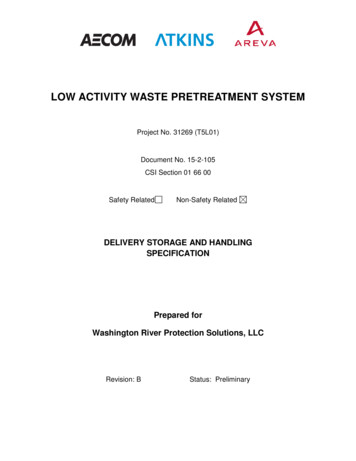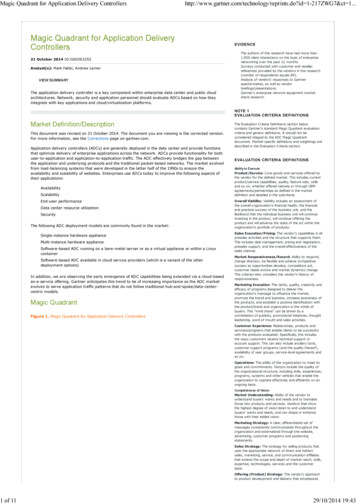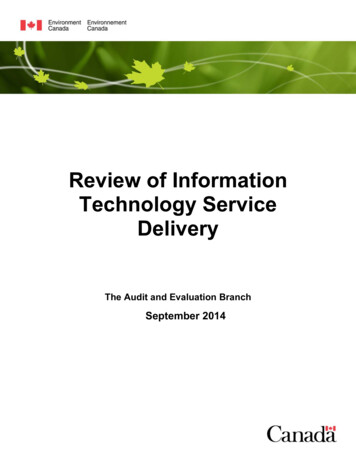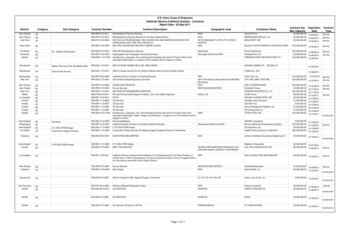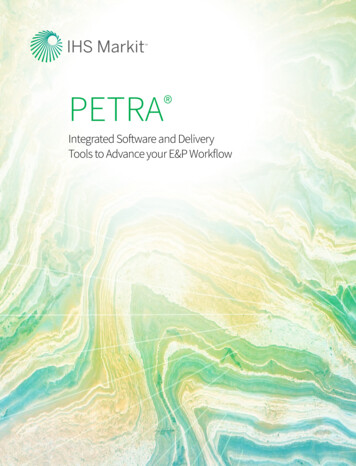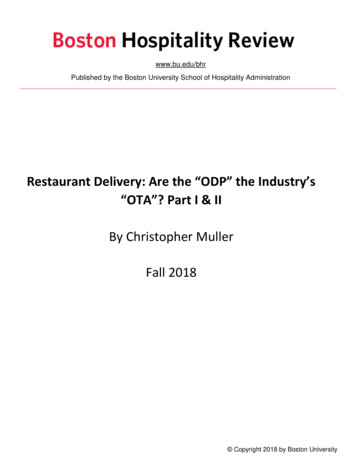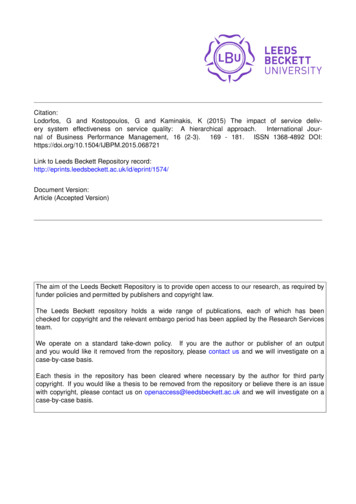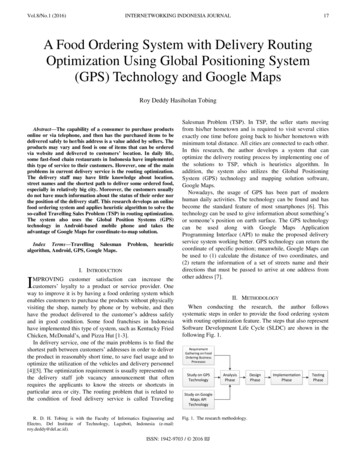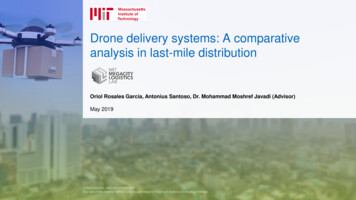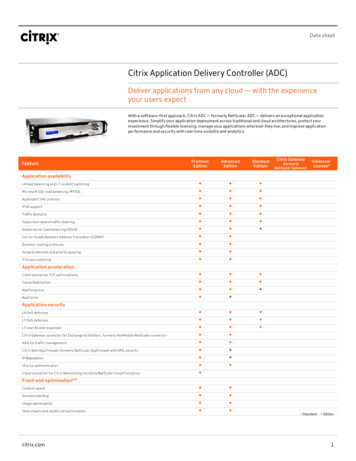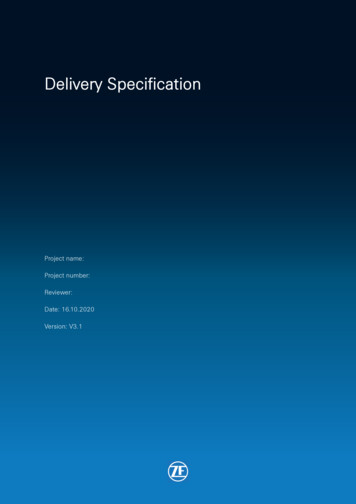
Transcription
Delivery SpecificationProject name:Project number:Reviewer:Date: 16.10.2020Version: V3.1
Copyright ZF Friedrichshafen AGThis document is protected by copyright.Complete or partial reproduction or distribution of this document is notpermitted without the approval of ZF Friedrichshafen AG.Infringements lead to civil and criminal prosecution.This document is a translation of the German original.
General Part1General Part1.1Scope of applicationThe "ZF Technical Delivery Specifications for Machines and Machine Systems" (hereinafter called“Technical Delivery Specifications”) described here is valid for all ZF plants worldwide.The term “Contractor” refers to the supplier of the machine/machine system, while the term “Customer”refers to ZF Friedrichshafen AG or the ZF location issuing the purchasing order.1.2General Requirements1.2.1Order of precedenceThe relationship and order of precedence of these Technical Delivery Specifications regarding otheragreements between Customer and Contractor are governed elsewhere, usually in the framework contractor in the minutes of negotiation.The Contractor must notify the Customer about any contradictory statements within these TechnicalDelivery Specifications and cooperate on a solution.1.2.2QuotationList the costs of any workpiece-specific scope separately.The quotation must include information on all necessary media, connected loads, consumption values,dimensions and requirements for the installation site of the machine/machine systems.Submit a filled-out operating sheet (job card) for space and installation planning (based on Annex 3:Operating Sheet for Space and Installation Planning) when you submit your quotation.Furthermore, reference is expressly made to the compliance (e.g. Nondisclosure) with the latest "ZF Termsand Conditions of Purchase for Machines and Machine Systems".1.2.3Project scheduleWhen confirming the purchase order, the Contractor must send the Customer a detailed project schedulelisting the Contractor's plans for completing the order. The Contractor must automatically update thisproject schedule at least every four weeks and then submit it to the Customer.The Contractor must notify the Customer immediately about any changes to the project schedule thatthreaten to delay or compromise the completion of the order. Such changes require a release.EN3
General Part1.2.4Order processing/deviationsIf the Contractor has gained knowledge or realized - thanks to his expertise - that he is unable to providecontractually agreed services, or can only provide limited suitability for the intended purpose, he is obligedto notify the Customer of this immediately. If this requires deviations from the Technical DeliverySpecifications, they must be requested in writing, giving technical reasons, and they must be approved bythe Customer (they must be entered in the standard form, see Appendix 06). They only apply to thespecific order.1.2.5Overall machine functionIf the existing machines/machine systems are expanded and/or modified, the Contractor shall also beresponsible for the overall function of the machines/machine systems affected by the expansion and/ormodification, provided that no other agreement has been expressly made to the contrary.Any modifications of the machine/machine system performed while work is being done on the order shallrequire the written consent of the Customer.1.2.6EquipmentThe same equipment must be used within each machine/machine system. In other words, componentsand/or assemblies with the same function from different manufacturers may not be used.Only components, assemblies, devices, and process materials may be used that appear on the Customer’sapproved list. They must be in their original condition and without any modifications whatsoever wheninstalled. Unacceptable actions include the drilling of fastening holes, removing housing parts, modifyingshaft ends and altering circuits.The manufacturers' setup and installation instructions for devices and systems are binding.The Customer must be informed of any work equipment requiring inspection and facilities requiringmonitoring (components, assemblies and devices). They must be included in Annex 2 Overview list. Anagreement must be reached with the Customer on inspection periods (e.g. inspecting pressure vessels).1.2.7SubcontractorsThe Contractor must ensure that all subcontractors also comply with the Technical Delivery Specifications.The Contractor is responsible for arranging and coordinating this compliance.1.2.8Documentation of the ContractorIn the case of constructions and workpiece-dependent equipment commissioned by the Customer, thecomplete documentation (e.g. construction drawings, assembly and individual part drawings with partslists of the machine or machine system, fixtures and tools) shall become the property of the Customer inelectronic and copy-capable versions, and be made available without restrictions.4EN
General PartMachine parts list (Machine BoM) and ABC risk analysis for spare and wear parts: The ABC risk analysis to determine critical spare and wear parts for each machine type is created bythe Contractor with the help of the ZF template (Excel) (www.zf.com - ZF Supplier Board - Terms andConditions of Purchase - Technical Delivery Specifications - Annex 4). The analysis shall be performedaccording to the ZF standard template. A temporary version has to be made available to ZF 3 monthsafter design release, the final version at the latest before the delivery approval. The complete machine parts list including the critical spare and wear parts must be provided in Excel(preferably in the same format as the ABC risk analysis) and sent by e-mail to the ZF inbox machinebom@zf.com as well as to the ZF technical project manager with the subject "[ZFProjectID] [ProjectName] [ZF location] [your company name]". The lists under a) and b) are part of the machine documentation and therefore part of the machineacceptance (completeness, up-to-dateness).1.2.9Customer’s drawingsThe Customer must safely destroy all received drawings, including copies and other duplications, within areasonable amount of time.Furthermore, reference is expressly made to the terms and conditions (e.g. Nondisclosure) of the currentversion of the "ZF Terms and Conditions of Purchase for Machines and Machine Systems".1.2.10NondisclosureExhibits of the machines/machine systems intended for the Customer and the publication of videos,photos, drawings, technology data, etc., shall require the written consent of the Customer.Furthermore, reference is expressly made to the terms and conditions contained in the "ZF Terms andConditions of Purchase for Machines and Machine Systems".1.3Normative referencesAlthough the Technical Delivery Specifications may not indicate those aspects in detail, the Contractor isfully liable for ensuring that all requirements relating to the performance rendered by the Contractor –beyond the scope of the aforementioned Technical Delivery Specifications – that are derived fromregulations (e.g. EU directives, regulations and other applicable legislation) as well as standards andgenerally accepted rules of technology are adhered to (referred to in the following as “directives, standardsand rules”).To the extent that the present Technical Delivery Specifications refer to directives, standards, and rules oftechnology, the Contractor has to independently verify whether these are relevant for the service renderedand whether there are other directives, standards and rules that the Contractor must observe. In cases ofdoubt, the Contractor must contact the Customer immediately.Moreover, the Contractor will immediately inform the Customer if – thanks to his expertise in the matterconcerned – the Contractor has gained knowledge or realized that the performance/service to berendered for the Customer can only be used to a limited degree or not at all for the intended purpose.EN5
General Part1.3.1Other applicable documentsCurrently valid ZF Terms and Conditions of Purchase for Machines and Machine Systems (seewww.zf.com)NumberDescriptionDIN EN ISO 12100 Safety of machinery - Basic concepts, general principles for designVDI 3423Technical availability of machines and production lines - Terms, definitions, determination oftime periods and calculationTable 11.3.1.1Other applicable documents (additional for Europe)NumberDIN EN 60204-1DescriptionSafety of machinery – Electrical equipment of machines – Part 1: General requirementsTable 21.3.1.2Other applicable documents (additional for Germany)NumberVDA-LVEVDI 2856DIN 4150 Part 2§ 19 WHGGerman occupational exposure limit(AGW) acc. to GefStoffVTA LuftTA LärmDescriptionGerman Association of the Automotive Industry - Delivery specifications forthe electrical equipment of machines, machine systems and equipmentStandardized specification for inquiries and offers on machine toolsVibrations in buildings - Part 2: Effects on persons in buildingsFederal Water ActOccupational exposure limit in accordance with the Hazardous SubstancesOrdinanceTechnical Instructions on Air Quality ControlTechnical Instructions on Noise ProtectionTable 31.4DefinitionsThe definitions listed constitute supplementary information to DIN EN 60204-1, VDA-LVE,DIN EN ISO 12100 and VDI 2856.1.4.1Error listThe error list describes the sources, types and possible combinations of errors.1.4.2Operating modesThe Contractor must implement a secure automatic and initial setup operation in the machine/machinesystem.6EN
General Part1.4.2.1AutomaticDuring automatic operation, the production process of the machine/machine system runs automatically,regardless of whether the loading takes place manually or with automation.The following sub-modes are possible: "Semi-automatic (automatic without loading automation):The machine/machine system runs with manual feeding and/or removal of parts." "Fully automatic (automatic with loading automation):The machine/machine system runs with automatic feeding and/or removal of parts." "Home position return:When this function is selected, the machine/machine system automatically moves to a defined position(home position)."1.4.2.2SetupIn setup operation, every function must be individually selectable in compliance with the safety rules (e.g.reduced speed and/or power, enabling button, two-hand operation, safety light grid). The setup operationshall be coordinated with the Customer.1.4.3Substeps within the operating modes1.4.3.1Manual modeEach individually defined program step is executed with a start signal. All safety devices are active.1.4.3.2Running emptyAll parts within the machine/machine system or magazine are processed fully automatically when thecorresponding selection has been made. The feed inlet for processing additional parts will be blocked.1.4.3.3Stopping at cycle endWhen processing of the part is finished, the machine/machine system stops, e. g. in home position.1.5Process capability / Availability1.5.1Short-term process capability (machine capability)1.5.1.1General requirementsThe machine/machine systems must be capable of short-term process capability (machine capability) withthe respectively required properties for workpieces listed in the requirement specification in accordanceEN7
General Partwith the applicable inspection and/or procedural instructions valid for the respective division with a cmkvalue 1.67 or in accordance with other agreements.The short-term process capability (machine capability) shall be guaranteed by the Contractor until the endof the period of limitation for defects.1.5.1.2VerificationThe Contractor must prove the short-term process capability (machine capability) for the first time duringthe test run at the Contractor's plant. This is an essential part of the final acceptance criteria and is arequirement for final acceptance to be granted and the period of limitation for defects to end. In this case,the Contractor must satisfy the machine or system-specific requirements, respectively.1.5.1.3DefectsIf the Contractor is not able to verify short-term process capability (machine capability) during the test runat the Contractor's or during the acceptance process, the previously specified provisions apply.If the short-term process capability (machine capability) of the machine/machine system fails during thelimitation period for defects and the Customer is not to blame, the Contractor must correct this defectwithin a period determined by the Customer.If the short-term process capability is not achieved after a reasonable period, this shall be consideredabnormal. To address this issue and to solve any outstanding problems, negotiations shall be taken up byboth partners. The same also applies to serious damage during the period of limitation for defects.1.5.1.4Extension of the warranty periodIf the short-term process capability (machine capability) is not realized during the last month of thelimitation period for defects and the Customer is not to blame, then the limitation period for defects shallbe extended automatically by one month, respectively, until short-term process capability (machinecapability) is achieved.1.5.1.5Measuring equipment capabilityThe measuring and test equipment must be capable of measuring/testing the workpieces with a cgk 1.0with the required properties listed in the requirement specification or the accuracy required by theCustomer vis-à-vis standard parts.Moreover, the previously agreed provisions shall apply.8EN
General Part1.5.2Long-term process capability1.5.2.1General requirementsThe machine/machine systems must be capable of long-term process capability with the respectiverequired properties for workpieces listed in the requirement specification in accordance with theapplicable inspection and/or procedural instructions valid for the respective division with a cpk value 1.33 or in accordance with other agreements.The long-term process capability is to be guaranteed by the Contractor until the e
13.01.2021 · The ABC risk analysis to determine critical spare and wear parts for each machine type is created by the Contractor with the help of the ZF template (Excel) (www.zf.com - ZF Supplier Board - Terms and Conditions of Purchase - Technical Delivery Specifications - Annex 4). The analysis shall be performed according to the ZF standard template. A temporary version has to be made available to
